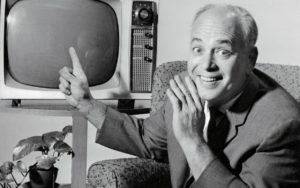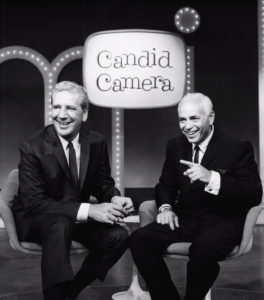
Human nature is a funny thing. Put people into strange circumstances, and the results can be hilarious.
Producer Allen Funt figured this out in 1947, and began a radio show called Candid Microphone, It was a hit, and also proved popular in the form of filmed theater shorts.
In 1948, in the very infancy of the medium, Candid Microphone made it to TV.
If you older Boomers don’t remember Candid Microphone, it’s for good reason. The show jumped all over the place before being merged into The Tonight Show as a recurring segment, followed by yet another move to The Garry Moore Show. Somewhere during all of the hopping around, the segment changed its name from Candid Microphone to Candid Camera.
Finally, in 1960, it appeared as Candid Camera, the TV show. And CBS now had a very solid 9:00 (Central time) anchor on the Must-See TV night of the decade, Sunday.

Bedtime for kids in the Enderland house was 9:00 sharp on Sunday nights. Ergo, I don’t have as many memories of Candid Camera as I wish that I did. But still, I can recall Allen Funt and Durward Kirby introducing short segments and my middle brother (who would sometimes successfully cajole dad into letting us stay up an extra half-hour) and myself collapsing in laughter. In typical kid-memory, what I recall most sharply was the “window blind” effects as a scene would fade in and out.
But thankfully, YouTube is well populated with classic scenes from the era, as well as from later incarnations of the show and the British version. Witness the “drive-in bank,” featuring frequent participant Fannie Flagg.
The show was a monumental hit. Eventually, its peering into human nature would be much imitated by shows featuring hidden video and user-supplied home videos of whoopsy-daisy moments. At press time, the concept has culminated (for better or, in most cases, worse) in the form of the first distinctive TV style of the 21st century: reality TV.
Funt deservedly gets the credit for the genius behind Candid Camera, but what you may not appreciate about him is the massive amounts of work that had to take place behind the scenes.
For example, cameras were huge, bulky things in the 50’s and early 60’s. While they could be hidden behind fake walls and such, they also required extremely bright lights. Thus, many candid scenes were filmed under the guise of “remodeling” work being done in the various locations involved.
Additionally, clueless network censors and sponsors who were paranoid about what constituted acceptable TV programming caused Funt misery. They needn’t have worried. Funt himself made sure each segment was squeaky-clean. According to the Museum of Broadcast Communications:
Funt himself destroyed any material that was off color, or reached too deeply into people’s private lives. A hotel gag designed to fool guests placed a “men’s room” sign on a closet door. The funniest, but ultimately unaired reaction, came from a gentleman who ignored the obvious lack of accommodations and “used” the closet anyway.
The show made for many a Sunday night laugh, then was unceremoniously yanked in 1967 despite barely slipping out of the Nielsen Top Twenty. It reappeared in a polyester-clad syndicated version in the early 70’s, with Funt’s guest hosts including Susan George, Betsy Palmer, and the aforementioned Miss Flagg. More recently, Funt’s son continued to carry the torch in a revamped version of the show until a couple of years ago. Indeed, look for Candid Camera to resurface again and again.